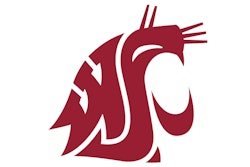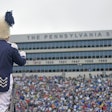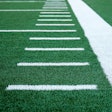

First off, what brought you to the United States?
I came as a student. IIT, here in Chicago. Illinois Institute of Technology, which was the architecture school in the late ‘50s. And then I went back to Germany and graduated in Munich with an architecture degree, and by that time I had made up my mind that I would officially emigrate to the United States. Now, I should also tell you that I have always had family in the U.S. My grandfather lived here, and he was a very, very famous architect. I worked with him.
Have you always been in Chicago?
Since 1962, I live here.
How much sports architecture have you done?
Relatively little, because that seems to be sort of specialized, generally, but for the renovation of Soldier Field around the year 2000, Mike McCaskey, one of the owners of the Bears, called me and hired me, because I had done several projects at the Museum Campus — the expansion of the Adler Planetarium, expansion of Shedd Aquarium with an oceanarium for whales and dolphins. I had a track record already of having done work in the area, and it was highly recognized and applauded by the public sector, the press, and he thought that I might be a good choice.
Had you ever worked on a stadium before?
No. You work with experts. You bring in that knowledge.
Who did you bring in?
First of all, we worked with the Bears and for the Bears. And it was a woman called Alice Hoffman who also was known as an experienced project manager for sports facilities, stadiums, and she was in charge of the effort in 2000 to 2003. And we’re talking again, together. She lives in Chicago, as well.
Are you a Bears fan?
In a way, I am — for the team and for the sport. Yes, I like watching it. But, having grown up in Germany, I’ve never played football in my life.
Which football — American football or European football?
I played soccer, but not American football. In Germany, in Europe, everybody plays soccer. In school, it starts early — kindergarten. The streets in the neighborhood, wherever. You kick a ball around.
Do you still prefer to watch soccer versus American football?
I’m very interested in FIFA World Cup. It’s a very, very big thing. And one of the things that we designed is the capability — the size of the playing field — to allow soccer and FIFA tournaments. And in my newest roofed-over version, that will be one of the features, that you can get the Super Bowl or FIFA World Cup to Chicago.
Is Soldier Field not wide enough for soccer as it stands today?
We have 63,000 seats. FIFA can easily draw 90,000. From that point of view, the current football stadium is not desirable. But it is important for you to understand that the reason the stadium is not wide enough is these memorial columns — the colonnades — on the east and west side for the veterans of World War I. It’s a memorial. It was designed as a memorial field. We preserved those exterior walls and colonnades, and I’m preserving it in the latest proposal I’m making.
Was it mandated that you couldn’t touch those columns, or was that your decision?
Well, it was both a little bit, because I had done these other things. The oceanarium was an addition to the Shedd Aquarium building, but I didn’t change the basic building. So, I had a respect for what is a historical monument, and I wanted to preserve it. On the other hand, it was a national landmark — protected. You couldn’t destroy or change it. And these considerations play a role now again, as well. The proposal that the Bears put forward, they keep the colonnades and rip everything off again, what we built in there. The colonnades will stay but they’re tearing down the existing Soldier Field football stadium.
When the Bears talked about moving from downtown to suburban Arlington Heights, how did that make you feel?
I thought it was a crazy idea, and that triggered me to think about how to make the existing Soldier Field attractive to them, because all I heard is what the current existing Soldier Field doesn’t have. It doesn’t have a roof, and it doesn’t have enough seats. So, I said to myself, “Well, why don’t I take a look at that and see if I can provide that.” And that was done strictly as an architect. I had no client. Nobody paid me for it. And I also feel very strongly that, you know, when you build these huge buildings like Soldier Field today, even without a roof, it’s a big building. And 20 years later, you want to tear it down? And then you want to spend billions of dollars to build a new one, with all the infrastructure needed — the parking and the roads and the bridges? Oh, my god. It doesn’t make sense to me.
You’re not alone. On April 25, the morning after the Bears released their renderings, 90 of the top 119 headlines pulled by a Google News search using the keyword “stadium” mentioned the Chicago Bears. I have never seen a sports venue story dominate the news like that. What is it about this project that warrants that kind of interest and coverage from the media?
Well, it’s a very controversial project, because on the same location a few years ago, we had a proposal for a museum to be built there with private money. And there was a civic group called Friends of the Parks. They sued, and they couldn’t build. They left town. And now the Bears want to put their thing on exactly the same spot. Friends of the Parks, I’m sure, will sue again very soon. It will be a battle. It will be a fight.
Are Friends of the Parks concerned about the loss of greenspace?
Public land on our lakefront. Yes. We also have a city ordinance in effect, called the Lakefront Protection Ordinance, and that forbids or prohibits anybody, particularly private organizations, from building on the public lakefront. It’s public land. That will be the other big issue. I mean, the Bears want to basically own the stadium so they can put a name on the door that gives them money, and they can rent it out to performance and entertainment and make the money themselves, rather than our Park District in Chicago, which, in the past, they owned these things. So, there is a lot of debate about this.
Do you share these concerns?
My impetus, or my concern, was more to just convince myself and others that it can be roofed over. In fact, the Bears called me a few years ago, the former general manager, and he said, “Can we put a roof over this?” I said, “Of course, you can put a roof over it, if you pay for it. It will cost a lot.” And the way I approached this is I said, “Here, we have a stadium. We cannot put columns inside the stadium, because they will block the views of the spectators of the playing field. So, we put four huge columns on the outside perimeter of the stadium and have cables holding up the roof made of ETFE [ethylene tetrafluoroethylene]. It’s very lightweight, and when the sun shows through it, green grass will grow underneath it. That’s amazing. It’s an amazing material, which 20 years ago we didn’t know about at that time — had never heard of it before.
When you talk about this former Bears official who reached out to you about the possibility of doming the stadium, was that at the time of the 2000 renovation?
It was talked about then. People on the Bears team and in the public sector thought this should be domed over so we can attract the Super Bowl to Chicago, primarily. That was the logic. But it was very expensive to do at the time, and the Bears didn’t want to spend the money. They said, “Oh, we don’t need that. We are a Chicago team. We play in ice and snow, and he will intimidate all the teams from the South who will freeze in Chicago, and we will win more games that way.” [Laughs.]
How much more cost would a dome have added to the last renovation? Would a dome have, say, doubled the cost?
Something like that. Yeah. I mean, what I’ve now proposed, in my opinion, will also still fall into the same category — it will double the value of the original building, you know?
Would your plan enclose the entire structure, or would Chicago’s temperatures still be a factor?
There would be conditioned air in there. The whole roof will be translucent but not necessarily transparent. In other words, you can still get a sense of whether the sun is shining or whether it’s cloudy. We have to enclose everything that’s there — the galleries, the different levels where the public goes, the restaurant — all of that will be enclosed. It will be an enclosed building.
Did you share these ideas with the current Bears administration?
I wanted to share them with the Bears, but they refused to see me. I never made a presentation to them, because they were already deeply engaged with what they’ve proposed. So, when they came out, I decided to publish mine, too. I sent it to a few TV stations. And my solution, right now, will be a fraction of the cost.
What is that comparison?
The newspapers have written that the whole project that they have proposed will be in the neighborhood of $6.9 billion. Mine will be under $1 billion, maybe, because everything else is there.
Once you hit the local media, did the taxpaying public sit up and take notice? “Hey, maybe this is the way to go.”
Some people have made comments like this or written them like this. Other people, of course, are enamored with what the Bears want to do. They don’t care about the cost. My whole motivation here is to do something that is very positive in Chicago and for the reputation of Chicago — on public land. Why do we have to have a stadium like every other city surrounded by big parking lots, for instance? I mean, some of these stadiums, you go out of the city, and you go to where the stadium is, and there are 20,000 cars parked all around. It’s not a very attractive environment. Certainly not a walking environment. Good for driving. But this is right in our city, right on our lakefront. People walk there all the time. They go to these big museums. And, by the way, I have also proposed to add a Bears history museum inside the building.
You talked about the shrinking lifespan of these facilities, but if the Bears had domed Soldier Field in 2000, would we even be talking about a new stadium now?
Probably not. Also, the decisions that were made were largely always bad decisions. Since everything, of course, has a cost factor, we developed solutions or possibilities and then we put a price to it. And they had to decide, “Do we want this? Do we want to spend that money?” And they got funding from the Illinois Sports Facilities Authority, an agency that funds these things by issuing bonds that are based on a hotel tax, tourism tax. And the cost of what they started doing — acquiring the stadium at Arlington Heights and already tearing it down — they now have big debts there. They also still have $1.6 billion, I believe, in debts in Chicago for the public park district that they haven’t paid.
Speaking about the sports venue industry in general, are we slowly marching toward a future in which all stadiums will be domed?
I think we are moving that way, because that allows them to be used more often and make more money. That’s the reason.
Granted, your sports experience isn’t extensive, but what factors into the decision to renovate an existing stadium versus building a new one?
In my opinion, it is just like any other renovation project. There are certain elements of a structure, of a building, whether it’s a stadium or an apartment building or an office building, that are sound and strong. The foundations usually can be reused for centuries. They’re not falling apart unless they were not properly done, which happens sometimes in less-developed countries. But you do replace certain things. The loads and the finishes and the water-tightness has to be brought down to the ground so that it doesn’t leak and drip on you in there. By the way, the design from me that has these large towers holding up the roof, basically the stadium will be exactly the way it is now inside, with only a roof over it. In other words, we’re not redoing the footprint or the plan, because we’re limited by the historic colonnades. Can’t move those.
Are your towers going to fit within the surroundings?
Because we’re next to a major yacht harbor in Chicago, Burnham Harbor, these towers, from a distance, will look like a bunch of big yachts anchored there. And if you look carefully at the Bears’ design, you will see that the big stadium building will be right next to the harbor, literally very close, because that’s all the space they have. And in the afternoon, when the sun is on the west side, that big building will throw a giant shadow over the harbor. The owners of these fancy yachts will not be happy about that.
Your solution won’t cast a shadow on the harbor?
No, because we’re in the middle, and we have plenty of land surrounding us.
One of the most popular feature articles in our magazine was published in 2012 under the title, “How Stadium Construction Costs Reached the Billions.” It was right on the heels of AT&T Stadium opening for the Dallas Cowboys. Now, just a dozen years later, we’re talking about that cost times six. What’s driving this?
That’s a little misleading, particularly to lay people. It depends what’s in the price. I mean, the $6.9 billion — that pays for all the bridges, roads, and parking lots and garages, as well, while the stadium itself will cost quite a bit less. On the other hand, there are now features — I mean, putting a roof over a big stadium, just think about it, there are 300 feet of clear span, meaning it’s like the Golden Gate Bridge. You can’t have columns underneath, and that costs money. That’s a very special, unique structure. I am driven, as a longtime Chicago architect, to do something that is in the spirit of the well-known, worldwide-known architectural history of Chicago. Something that fits, belongs and is acceptable. The key word is context.
In your opinion, does the Bears vision reflect the spirit of Chicago?
That is not contextual or respectful. For instance, I give you one little detail. The stadium we did, the existing one, is lined up on the axis of the Field Museum, which is the dominant building at the Museum Campus. We’re aligned with this museum, which was built 100 years ago or so. And the original Soldier Field, with the colonnades, was also aligned that way. And now the Bears are putting this huge box building at an angle in a location that doesn’t relate to anything. Also, the exterior design, the colors, it’s sort of brown-looking as if it was wood paneling or something. Anyway, I don’t know enough about it. I haven’t seen the detailed plans.
Taxpayers are footing half of the $1.4 billion tab for Jacksonville’s stadium renovation, what the Jaguars are calling the Stadium of the Future. And not long after the Jacksonville project was announced, Kansas City voters rejected the idea of helping fund the renovation of Arrowhead Stadium, which would have effectively prevented the Chiefs, the two-time defending Super Bowl champions, from even threatening to leave.
It’s amazing — a winning team.
Where do you come down on public financing for these stadium projects?
Well, I guess I’m not an expert at this, but I think it has to be decided on who owns what in the future. In other words, if you build a parking garage under public land, the Bears, the football team, shouldn’t earn that income. That should go to the public owner. And then you can get public money, because the public will get the money back over the years, you know? That, to me, makes some sense.





































